Statewide Fisheries Research - Current Projects

The goal of the Freshwater Fishery Research is to obtain relevant and sound information that improves the Department's ability to manage and conserve the aquatic natural resources of South Carolina.
Downloadable documents below are in the PDF format.
- Assessment of condition, growth, contribution to fish community, and diet
of striped bass, white perch, and American shad young-of-the-year in the
Santee-Cooper lakes, South Carolina -
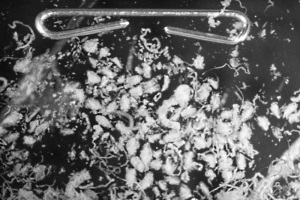
The Santee-Cooper system contains a naturally reproducing population of striped bass that also receives supplemental stockings annually. Annual recruitment of stocked and naturally produced striped bass to the fishery is highly variable. One hypothesis for this variable recruitment is competition for resources by other fishes. The growth, diet, and relative abundance of several young-of-the-year fishes, including American shad, striped bass, white perch, and threadfin shad are being evaluated to determine the potential for resource competition.
- Assessment of habitat installation into Lake Hartwell
-
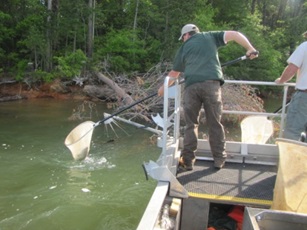
As a result of Polychlorinated Biphenyls damage, SCDNR has received a substantial amount of money to improve habitat in Lake Hartwell. Various types of structures will be placed into Lake Hartwell to enhance the fishery. As part of this effort, Research is working with Region 1 and Clemson University staff to assess the level of change in the fishery associated with habitat installation. In spring of 2015, a pilot study was undertaken to evaluate whether a method could be developed that would allow biologists to estimate the total number and weight of Largemouth Bass greater than 12 inches in a 100 acre cove of the lake, which had depths of up to 40 ft. The effort was just completed and was successful. It was estimated that approximately 250 bass were in this cove during a 10 day period in April. In the future, we hope to compare the populations in coves with and without habitat installation.
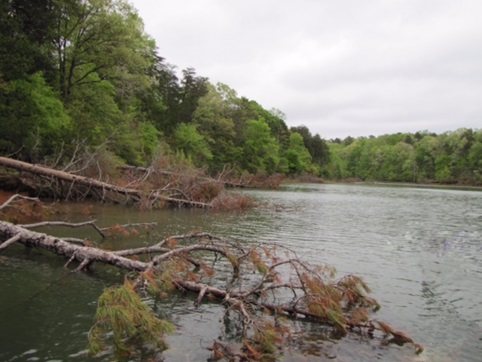
- Conservation of Redeye Bass in South Carolina
-

Since 2004 we have documented the rapid decline and loss of Redeye Bass populations in Savannah Basin Reservoirs due to hybridization with introduced Alabama Bass. Though not native to South Carolina waters, Alabama Bass have expanded widely since their unauthorized introduction into Lakes Keowee and Russell. Their impact to native Redeye Bass has been dramatic. From 2004 to 2010 redeye numbers declined precipitously in Savannah Basin reservoirs, while hybrids between Redeye and Alabama Bass increased. Results indicate that the continued presence of Redeye Bass in Lakes Jocasee, Keowee, Hartwell, and Russell into the future is certainly in doubt. While Redeye had thrived in these reservoirs historically, the species native habitat is the cool flowing Piedmont streams and rivers that feed them. We are currently surveying these populations, working to delineate the upstream reach of Alabama Bass and their hybrids from the reservoirs. The identification of pure stream populations of Redeye Bass, and the habitats they are associated with will help to define management objectives for conserving native Redeye Bass.
- Crappie Data Compilation and Assessment
-
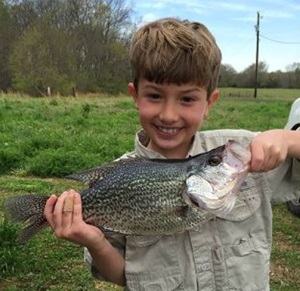
The crappie sport fishery is important in South Carolina, supporting both recreational angling and a number of local and national tournaments each year. Crappie populations are routinely tracked by trap netting, which provides an index of year class strength for individual reservoirs, and age and growth studies. Our statewide data is being compiled to enable comparisons among populations, assess current data and how it is used, and to identify critical data gaps. Growth estimates differ among reservoirs, but our relative lack of data for fish over age 4 impacts assessments of growth and mortality. Longevity of these fish, and their maturation schedule on South Carolina reservoirs are also information gaps. We are assessing other collection methods including tournament sampling and Spring electrofishing.
- Development of a monitoring plan for Broad River Smallmouth Bass
-
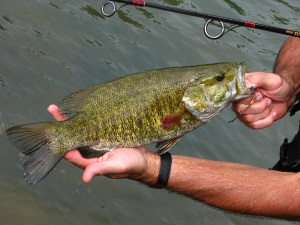
A thriving fishery for smallmouth bass exists in the Broad River; however, due to poor river access, poor capture efficiency, and difficult navigation a suitable method to assess smallmouth bass abundance and population structure has not been developed. In conjunction with Clemson University we are evaluating mark-recapture techniques as a tool to better monitor and manage the smallmouth bass population in the Broad River.
- Environmental DNA detection of Blackbanded Sunfish
-
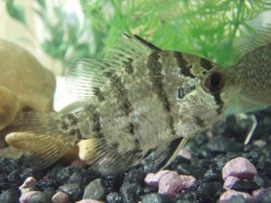
The intent of this project is to provide a comprehensive assessment of the distribution, relative abundance, and genetic health of SC and GA populations of blackbanded sunfish, a species of conservation concern generally found in the Coastal Plain of South Carolina. We will develop an environmental DNA(eDNA) tool that will allow us, through collection of a water sample, to determine if blackbanded sunfish are present in specific watersheds. The eDNA tool will be combined with traditional fishery surveys and population genetics to develop improved management and conservation plans for blackbanded sunfish. Initial field sampling is expected in 2015.
- Growth, survival, abundance, and outmigration patterns of juvenile American
Shad and Blueback Herring in the Santee-Cooper lakes -
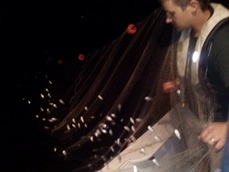
In order to restore and enhance diadromous fish resources in the Santee watershed, conditions in the juvenile nursery areas need to optimize survival and maximize successful outmigration. The goal of this effort is to collect sufficient young-of-year (YOY) juvenile shad and herring to determine abundance, distribution, growth rates, food habits, and out-migration timing. We are determining abundance of these species, and resident species such as threadfin shad, by conducting night-time hydroacoustic evaluations. Just like a common fish finder, hydroacoustics uses sound waves to locate and estimate the abundance of fish within the water column. To date, studies have provided estimates of the total abundance of forage species, with threadfin shad dominating the forage; American shad juveniles comprised approximately 10% of the community. Growth and migration patterns of key fish species have been defined. Monitoring will continue through 2015.
- Developing Sediment Management Guidelines to Enhance Habitat and Aquatic
Resources in the Broad River Basin -
Defining the relation between aquatic communities and changes in physical habitat.
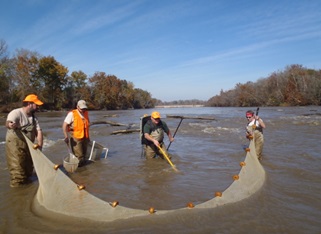
Sedimentation is a source form of aquatic habitat degradation in rivers and streams. Many rivers of the South Carolina Piedmont exhibit chronic effects of sedimentation due to historic land use practices. In addition, acute sources such as in-stream sand mining operations may alter sediment dynamics.
The Broad River basin supports a diverse aquatic assemblage including approximately 60 fish species, or more than one third of South Carolina's native freshwater fish fauna. Many of these species require clean, undisturbed substrates for fulfillment of life history processes including reproduction. Shoal habitats in particular provide critical spawning grounds for many native fishes, yet these habitats are susceptible to sediment deposition. Effective management of sediment in the Broad River basin is an important tool to help preserve habitat quality and aquatic species diversity.
In this effort, we aim to characterize relationships among sediment, aquatic habitat condition, and biological assemblages in the Broad River basin, with three primary objectives:
- Assessment of relationships among stream habitat, sediment and fish assemblage structure
- Evaluation of fish spawning success in relation to substrate and sediment composition
- Assessment of sand mining impacts on local habitat, sediment and fish assemblage structure
Relationships will be used to develop management targets for maintaining suitable aquatic habitat and species populations in the Broad River basin.

- Population structure and behavior of Great Pee Dee River Striped Bass
-
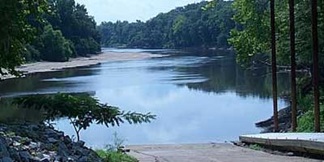
The Great Pee Dee River supports a population of reproducing striped bass. Current perceptions are that the population is relatively small and has possibly decreased in size over the last several decades. SCDNR is interested in augmenting this population. However, certain information needs to be obtained before any augmentation effort can begin. Genetic information is needed to learn whether Great Pee Dee striped bass are a unique stock. Initial samples were obtained in 2013 from the North Carolina section of the river. These samples indicated that those fish were dominated by a coastal, North Carolina genetic signature, perhaps migrating down from upstream North Carolina reservoirs. Efforts are currently underway to obtain samples throughout the entire Pee Dee river, from Winyah Bay to the North Carolina line, to see if the whole river is dominated by coastal North Carolina fish. This information is needed to determine what stock of striped bass to stock, should stocking become an option. Behaviorally, five striped bass were implanted with transmitters. Initial results showed that while some fish stayed in the upper section of the river, other fish used the whole river during varying times of the year. In 2015, two additional fish were implanted with transmitters.
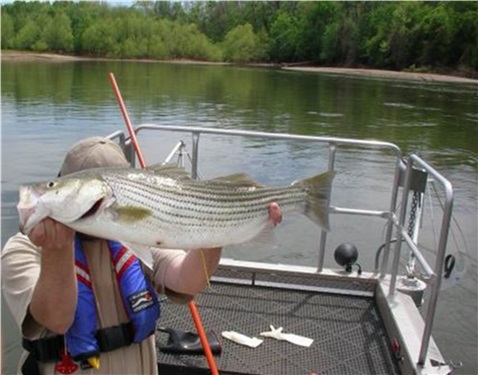
- Redbreast Sunfish Edisto River Stocking Assessment
-

The Edisto River has been routinely stocked with redbreast sunfish since 1995, but the contribution of hatchery stocking to this popular fishery has never been assessed; we are conducting that assessment. We stock a prescribed area of the Edisto River with marked redbreast fingerlings from hatcheries and assess their contribution to the entire population. Stocked redbreast fingerlings are marked by immersion in oxytetracycline (OTC). Fish are collected the following Fall from 4 Zones within the stocking area, and from two equal zones above and two below the stocking area. Data from the 2010 year class assessment indicates hatchery contribution within the stock zones of about 14%. Contribution from the two sampling zones downstream of the stock area was 5%. No marked fish were collected from the upstream segments. Losses of known marked fish and poor OTC marks precluded our assessment of the 2011 and 2012 year classes. This study is continuing with assessments of the successfully marked and grown out 2013 and 2014 year classes. We are very much looking forward to this data, and to determining the contribution that hatchery stocked fish are providing to this important fishery.
- Small River Assessment
-
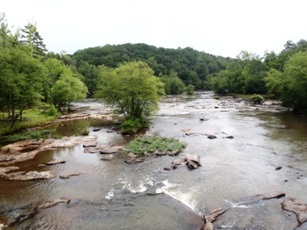
South Carolina contains approximately 2,000 miles of small rivers—those draining watersheds between about 60 and 800 square miles. Small rivers are a significant yet understudied aquatic resource. Data from wadeable streams of the South Carolina Stream Assessment show a pattern of increasing aquatic species richness with watershed area. Furthermore, both abundance and density of conservation priority fish species exhibited trends suggesting increases beyond wadeable streams and into small rivers. Characterization of small rivers is an important part of stream and river conservation in South Carolina, building upon the conservation framework established by the South Carolina Stream Assessment.
The Small River Assessment was initiated in 2014 to:
- design an effective sampling program to collect data representing physical, chemical, and biological conditions in small rivers across South Carolina, and
- implement a standardized data collection protocol at selected sites.
From this data we will then be in a position to define the influences of physical and chemical conditions on living aquatic resources and map current population status. After these steps, we will be able to incorporate the modeled relationships into our decision support tool to allow predictions based on anticipated changes in the landscape. Specific benefits from this work will include:
- Improved understanding of aquatic species' habitat requirements, population status and current distribution.
- Data to populate decision-support system models - implemented in GIS to make forecasts of consequences of specific management actions or risk assessments of proposed land uses for aquatic habitats and dependent species, specific to a given location on the landscape.
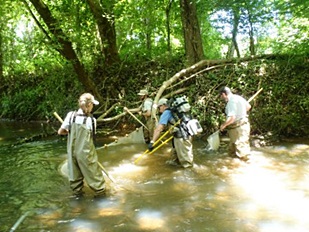
- Trophic resources for fish in Lake Marion
-
Lake Marion is the largest (330 km2) impoundment in South Carolina. It supports valuable fisheries for striped bass, largemouth bass, crappie, catfish, and other species. The overall goal of this project is to describe the food web (essentially who eats what) in Lake Marion. Obtaining this information will assist fisheries management decisions by identifying energetic factors that can limit the abundance of a species of interest.
The focal region of our studies has been the main basin of upper Lake Marion, and the focal season has been spring, when this region serves as a nursery for striped bass, American shad, blueback herring, and other species of interest and concern. Our approach includes field studies (of zooplankton, phytoplankton, benthic invertebrates, and larval fish), data analysis, and mathematical modeling. Because the survival and growth of the larval fish requires an adequate supply of zooplankton, we are particularly concerned with understanding processes influencing the abundance of zooplankton in spring.
Our studies to date have shown that the food web in the upper main basin of Lake Marion is dominated by invasive mollusks, the Asiatic clam Corbicula fluminea and the olive mystery snail Viviparus subpurpureus. In the figure below, the size of each box is proportional to the mass, or weight, of each organism. Arrows show interactions among the various types of biota; red arrows show consumption;
blue arrows show transport associated with flow; dashed lines indicate greater uncertainty about the size of the component or the magnitude of the transfer rate.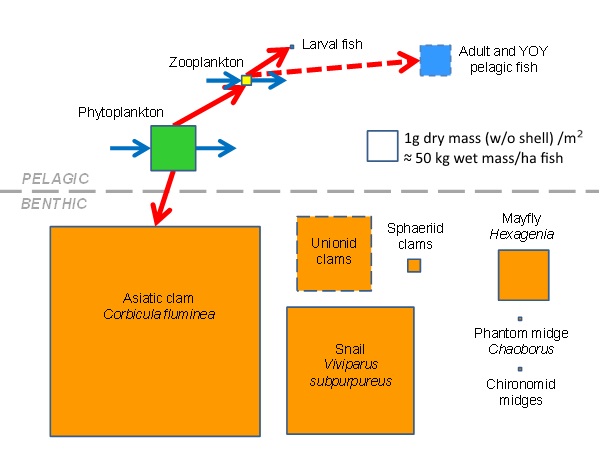
Thus far, our study indicates that:
Flow rates in Lake Marion exert a substantial effect on the abundance of phytoplankton
Corbicula filter feed on the phytoplankton and also can affect phytoplankton abundance
Reduction in phytoplankton may affect zooplankton, larval fish, and other pelagic consumers, such as threadfin shad, in the upper lake and throughout.
Zooplankton abundance is probably controlled by flow during periods of high discharge, but by fish predation during periods of lower discharge.
Benthic insects, such as the mayfly Hexagenia limbata, are heavily consumed by both forage and game fish.
